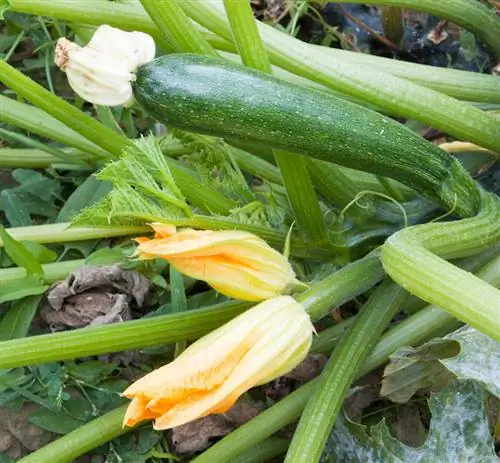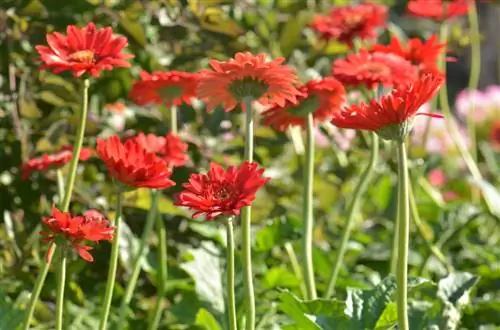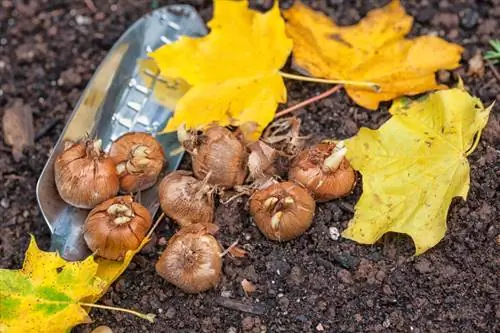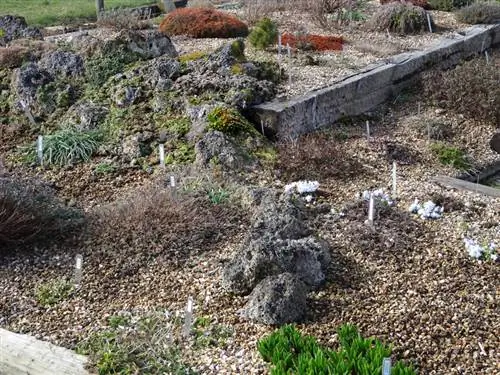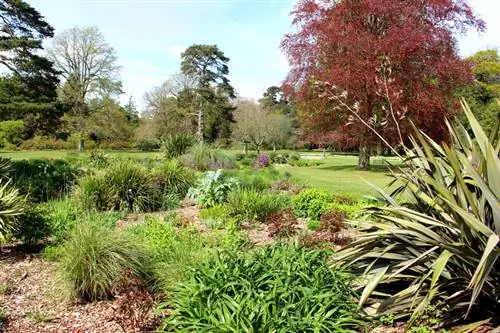- Author admin [email protected].
- Public 2023-12-25 17:45.
- Last modified 2025-01-23 11:21.
The bright golden-yellow flowers to which the yellow loosestrife (bot. Lysimachia punctata) owes its name decorate the garden in early summer. The native, hardy perennial thrives even in difficult locations and is also considered extremely easy to care for. The perfect choice for the uncomplicated perennial garden! But be careful: the plant, also known as pennywort or spotted loosestrife, tends to grow quickly.
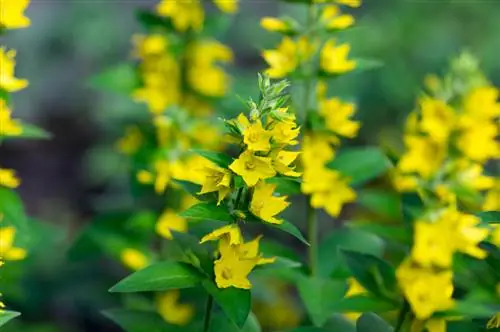
What are the characteristics and care requirements of the golden feline?
The yellowfield (Lysimachia punctata) is a hardy, perennial with bright golden yellow flowers that blooms from June to August. It prefers sunny to partially shaded locations and requires nutrient-rich, humus-rich, moist soil. The plant tends to overgrow, so root barriers or regular sucker removal should be used to control spread.
Origin and distribution
Botanically, the yellow loosestrife belongs to the primrose family (Primulaceae) and is very widespread in a wild form in central and southern Europe. You will find the magnificently flowering perennial, which probably originally comes from Turkey or southeastern Europe, primarily on river and stream banks as well as in damp meadows. Lysimachia punctata has been cultivated in gardens for several hundred years, from where the very fast-growing plant made its way into the wild.
Usage
In the garden, the yellow loosestrife is used primarily in perennial beds, either as a lush single planting or in combination with other sun-loving perennials such as cranesbill (Geranium), purple loosestrife (Lythrum salicaria), sedum (Sedum), lady's mantle (Alchemilla), flame flower (Phlox), lupine (Lupinus), summer spar (Spiraea) or various ferns. Combinations of different varieties of goldfelberich also look very pretty.
The distinctive perennial comes into its own wherever other flowering plants find it difficult to thrive: it is suitable for small embankments, nutrient-poor or otherwise difficult locations (e.g. splintered areas) and for edge planting (e.g. on garden ponds or along groups of trees). Goldfelberich is excellent and creates flowering oases from unsightly garden spots in no time. It is also one of the characteristic flowering perennials of a traditional cottage garden.
Furthermore, the golden feline is suitable - especially when combined with different colored summer flowers and grasses - as a durable cut flower for colorful bouquets.
Growth
It is a perennial, herbaceous perennial that can grow up to 100 centimeters high. Plants planted individually form runners very quickly, all of which are connected to one another via a common root system. Numerous, upright and unbranched stems sprout from the thick roots. Goldfelberich quickly grows and covers bare spots in the garden. However, the strong growth must be stopped through appropriate measures, otherwise the robust perennial will crowd out other plants.
Goldfelberich copes very well with root pressure, which is why it is also very suitable for planting under trees and standard trunks.
Bloom and flowering time
The heart of the goldfelberich is its bright golden yellow flowers, which appear numerous and lush between June and August. The individual flowers sit in groups of three or four comparatively large individual flowers close together in the leaf axils. They form a large, tier-like panicle that catches the viewer's eye from afar.
leaves
The bright summer green foliage is also arranged in a whorled and tiered manner on the stem. The individual, dull leaves have a lanceolate shape with a broad base, are smooth, have entire edges and are rather coarse. The leaves at the bottom are longer and wider than at the top of the plant, and they shrink evenly from bottom to top.
Fruits
The Goldfelberich produces capsule fruits in autumn, which, if you are not careful, will self-sow over large areas. The seeds also spread through the wind and reach distant garden areas - or even the neighbor's garden.
Is goldfelberich poisonous?
Lysimachia punctata is not poisonous to humans, dogs, cats and other animals and is therefore ideal for the family garden. The herb can only be dangerous for small rodents such as rabbits or guinea pigs, which is why runs should not be set up in the immediate vicinity of a plant. However, the small animals usually avoid the plant on their own.
In earlier times, the goldfelberich was also used in folk medicine, for example to relieve or heal inflammation.read more
Which location is suitable?
Lysimachia punctata feels most comfortable in a sunny to partially shaded location. A lot of sun allows the flowers to shine even more, but the perennial also does well in places with less light. It just shouldn't be completely dark: you should choose more suitable plants for the shade.
What soil does the plant need?
So that you can enjoy the magnificent flowering perennial even more, it is best to plant it in loose, nutrient-rich, humus-rich and rather moist soil. Whether it is sandy, clayey or loamy, light or heavy, doesn't matter - it just needs to have good water storage capacity. Goldfelberich needs a lot of water, which is especially important for sunny locations. However, the plant also tolerates dry phases well for a short time.
Mulch the soil, for example with a mixture of well-rotted compost and bark mulch, so that the moisture remains in the soil longer. This not only provides the perennial with nutrients, but also reduces the amount of care required.
Sowing and planting
Between April and June, plant the goldfelberich seeds straight away in the desired location. Prepare the soil well, loosen it with a hoe and rake, remove weeds and, if necessary, mix mature compost into the potting soil. After germination, separate the plants at a distance of approx. 20 centimeters each.
Advance
Since goldfelberich usually germinates very quickly, it is not necessary to grow it early. If you still want to do it, put the plants on the windowsill at the beginning of March and put them in the garden bed after the Ice Saints. Autumn is the right time to plant rooted cuttings.
What is the best time to plant?
You can plant young plants in the bed either in autumn or spring. The only requirement is that there is no ground frost and none is expected for the next few weeks.
The correct planting distance
There is space for around eight to ten plants per square meter, although you should ideally maintain a planting distance of around 30 to 40 centimeters.
Culture in pots
Goldfelberich is very suitable for container cultivation. Choose a pot that is as wide and deep as possible and a nutrient-rich, humus-based substrate (alternatively, mix conventional potting soil with compost soil) and ensure an even and balanced supply of water and nutrients. With regard to fertilization, it is basically sufficient to replace the plant substrate annually with the mixture already mentioned. The loosestrife is a stoloniferous, deep-rooted plant that requires a lot of space in its planter.
Propagate Goldfelberich
Lysimachia punctata is very prolific. The easiest way to reproduce it is to divide groups of plants that have become too large, which you should do if possible in late summer or early autumn. Alternatively, division is also possible in spring. To do this, dig up the plants and divide the rhizomes with a sharp, clean knife or hedge trimmer. At least two strong shoots should remain per root section.
Alternatively, you can propagate the golden loosestrife via the root runners that inevitably appear, which you carefully dig up and separate from the mother rootstock. You can generally carry out this measure throughout the entire growing season.
Limit
The strong growth and tendency to overgrowth have already been mentioned several times. In order to prevent uncontrolled spread, containment makes sense. This can be done, for example, with a stone root barrier around the perennial bed. Regular removal of the root runners also helps to keep the herb within its limits.
Watering Goldfelberich
Goldfelberich likes it moist, which is why it needs to be watered regularly in dry locations during the summer months. In naturally damp places, such as on the banks of a pond or stream or on a damp meadow, an additional water supply is not necessary. But be careful: waterlogging is detrimental to Lysimachia punctata - like so many other perennials - and leads to root rot, which leads to disease and ultimately to the death of the plants.
Fertilize Goldfelberich properly
For planted goldfields, fertilization is only necessary every two to three years. Mature compost is suitable for this purpose and can be used for mulching, possibly mixed with grass clippings.
How do I transplant correctly?
Goldfelberich can be transplanted very well, which can be done in spring or autumn. You can use this opportunity to divide rootstocks that have become too large and gain additional plants.
Cut Goldfelberich correctly
Unless you want to collect seeds, dead stems should be cut off in autumn. Take a radical approach and only leave a residue about a hand's width high. If this measure has been missed, the pruning can be done before budding in the spring.read more
hardy
Goldfelberich is absolutely hardy, which is why special measures in the cold season are unnecessary. Be careful not to water the plant in winter, especially when temperatures are below freezing.
Pests
The robust wildflower is rarely attacked by pests. Only snails find the young and tender shoots very tasty, which is why setting up a snail fence is a sensible measure.
Caterpillars and sap-sucking pests such as aphids are also rarely found on goldfelberich. Plant manure (especially from comfrey or nettles) helps against these uninvited guests; caterpillars should also be collected and severely affected plant parts should be generously cut back and disposed of directly with household waste.
Diseases
Lysimachia punctata also shows great resistance to diseases. Basically, only rot can become a problem. The main reasons for this are locations that are permanently too wet, too cold and/or too dark. If the plant shows signs of rot - for example by appearing to dry out despite seemingly sufficient soil moisture or frequent watering and also smelling musty and the soil becoming moldy - it can sometimes be helped by digging it out, cutting back both the upper parts of the plant and the roots as well as a Implement to save.
Withered, rotten or yellow or brown discolored sections and leaves should always be cut off thoroughly and disposed of with household waste. Such plant parts can contain fungal or other pathogens that multiply splendidly in the compost and would infect other garden plants from there.
Goldfelberich is not blooming
If the goldfelberich is not blooming, there can be various reasons. The most common reason for the lack of flowering is a location that is too dark: Even though it is often claimed that Lysimachia punctata also thrives in the shade, this information should be treated with caution. The perennial actually needs a lot of sun and warmth to bloom lushly, which is why a partially shaded location is necessary.
The second cause of weak or no flowering is a substrate that is too lean and therefore a lack of nutrients. However, you can quickly remedy this situation by adding suitable fertilizer. Compost is very suitable for this, but you can also water the goldfelberich with a nutrient-rich plant manure made from comfrey, nettles and rock dust. This also has the advantage of working much faster than compost.
Tip
To keep Lysimachia punctata's growth in check, simply cut off regularly flowering stems close to the ground in the edge areas. These can be used wonderfully as cut flowers for the vase and look particularly good in combination with various colored summer flowers, flowering perennials and grasses.
Varieties
Lysimachia punctata ‘Hometown Hero’
'Hometown Hero' is a fairly low variant that reaches heights of between just 40 and 70 centimeters. The clump-forming plant reaches a diameter of up to 250 centimeters in width. The large flowers appear between June and August and have a darker yellow color compared to the wild variety, and the foliage is also a deeper green.
Lysimachia punctata ‘Alexander’
The most striking feature of this interesting variety is the two-tone white variegated foliage. The variegated leaves form an exciting contrast to the large golden yellow flowers, which appear like the wild form between June and August. This variant grows significantly less than the species, but is more sensitive to frost. At least in the first few years, 'Alexander' needs light winter protection, for example by covering the planting area with fir or spruce branches after pruning. The variety reaches an average height of up to 70 centimeters.
Lysimachia punctata ‘Golden Alexander’
The variety 'Golden Alexander' has the same characteristics as 'Alexander', but in contrast to it has attractive, two-tone gold-edged foliage.
Lysimachia punctata ‘Senior’
The 'Senior' variety, which grows up to 80 centimeters high, is considered robust and uncomplicated. It is vigorous, develops a lot of root runners and is therefore perfect for overgrowing larger areas. Planting up to six plants per square meter is recommended.
Lysimachia x cultorum ‘Candela’
This is not a variety of the golden feline, but a white-flowering hybrid. The species, also known as autumn loosestrife, shows beautiful white, star-shaped flowers between July and August. The plant reaches heights of between 25 and 40 centimeters, develops numerous root runners and is therefore often used as a ground cover.
Lysimachia clethroides, Snowfellow
This loosestrife species impresses with its pure white, delicate and slightly overhanging inflorescences. The quite large flowers, measuring about ten centimeters diagonally, appear quite late between July and August. The snowfellow grows up to 80 centimeters high and 40 centimeters wide, but is significantly less vigorous than the goldfellow. Lysimachia clethroides also requires light winter protection.
Lysimachia ciliata, ciliated loosestrife 'Firecracker'
This beautiful loosestrife has striking, dark red foliage that creates a striking contrast to the bright yellow flowers. The strong-growing foliage perennial grows up to 80 centimeters high and requires similar location and care conditions as the closely related goldfelberich.


